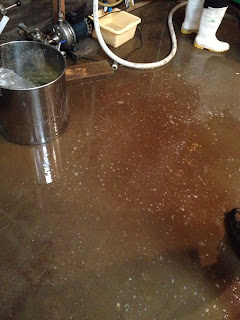The brewery was primed and ready to go. And we had the perfect recipe to test the apparatus. The 7: designed by engineer and brewer Jerry Wayne to reflect the characteristics of the Lotus 7, light, fun and fast (fast drinking that is).
Vrrrrooooooom!
I was always going to be a late arrival to the brewery on that particular Sunday, owing to the necessity of taking my puppy to her training classes. Does anyone remember that tiny sock-looking thing I posted a picture of a while back? Well, she's now absolutely monstrously enormous.
Here she is sleeping in a puppy heap with Alan and Jen's dog Charlie. Awwww.
So when I got to the brewery it was complete choas already and I hadn't had a chance to get a handle on how it had got that way. My first impression was just SUCH a lot going on. The two big 500L kettles outside were humming away, busy getting up to temperature for the mash in, grain was being milled, people were everywhere, eating pies, and curries and yelling and laughing. A lovely young couple were testing their homebrewing skills making some Kölsch for their wedding (which now I think about it is coming up very soon! Congrats Kat and Neil).
Then came the mash in. With the expert guidance of Ben Middlemiss and Alan Knight we got all the grain for the 350L test batch of 7 mashed in with the tiny rouser from the 50L home brew system. The melanoidin malt gave the converting wort in the tun the most gorgeous orange glow. Photographs sadly do not do it justice, so I will let you use your imagination.
Things seemed to be going so well. But we knew better than to relax. The 7 wouldn't be safe until it was safely tucked into its lovingly prepared 450L fermenter.
Conversion took place, and a negative starch test gave us the green light to begin sparging and runoff to the kettles. The boil proceeded well, and 7 glorious hop additions lent their fragrance to the air.
And then.
It was time to test the hop-back, the pipework and crucially, the heat exchanger.
The thing about making beer is that once you finish boiling and adding hops, you really do need to get it from almost boiling to around 18°C as quickly as possible. You see, while the wort is boiling it's arse off, it is busy-busy producing a rather nasty chemical called dimethyl sulfide. When it's boiling, it's not a problem because it gets evaporated off, but as soon as the boil stops, the wort is sitting at a dangerous temperature. That at which DMS can form, but not dissipate. The result is that it sits in suspension and makes the finished beer taste and smell like rotting tinned corn.
We were all very keen to get the wort through the 88 plate industrial heat exchanger as soon as possible. And that's when we hit a snag.
The hop-back blocked, and the heat exchanged jammed full of hop particles.
About 50L of 7 wort went all over the floor.
So the floor was very, very wet.
Luckily, the lovely homebrewers had finished using the tiny heat exchanger. Er... yes. The very small one that we normally use for the 50L system. It was going to be a very slow and nerve-wracking run-off.
Finally, we got the remaining 300L of 7 into the fermenter.
Then, the clean-up. Since I am the smallest brewer on staff I was nominated to climb in and dig out the mash tun. Luckily I had Alex and Tim to help me.
The next day, a domestic air-conditioning unit was positioned in front of the fermenter to keep the wort at correct fermentation temperature.
And eventually the wort finished fermenting. We ran off samples, we tested gravities, we tried the glorious elixir of gold it had become. We were ready to keg and condition.
Let's just move this air-conditioning unit out of the way so we can get at the beer more easil-Fuuuuuuuuuuuuuuuuuuuuuuuuuck!
The air-conditioning unit over-balanced, the corner landing on the spigot, shearing it clean off.
Beer was going everywhere. Alan, with reflexes born of long experience, stemmed the flow with both hands, while Alex and I dashed about finding any available vessels that could be sterilised and filled with 7 quickly. We ended up using pretty much every 30L fermenter in the place. It was coming so fast we probably lost another 20L to the brewery floor, so at least it has now been thoroughly christened.
We reviewed our notes over a pint of what is now referred to as The Lucky 7. Hopefully our next brew will be much less eventful.
Happy brewing chaps!





Came here from Reddit. After all this, I *really* want to try this brew! Any chance to ship to America when it's all done?
ReplyDeleteI'm going to look into the possibility of this in the morning.
ReplyDeleteIt's definitely a beer worth trying - it has basically finished conditioning now because I need to blog about things a lot faster than I do.
How do you think it would travel? I've never sent beer that far before.
ah yes and a good day brewing was had by us all.
ReplyDeleteHops makes you happy :-)